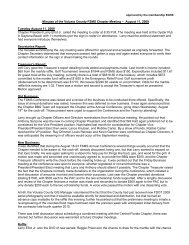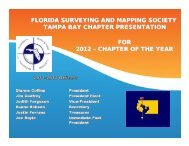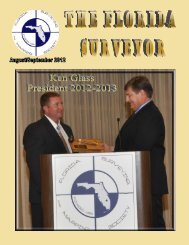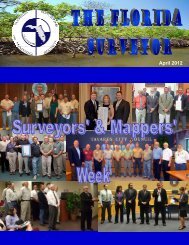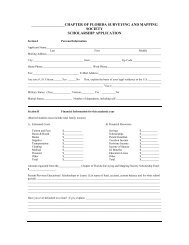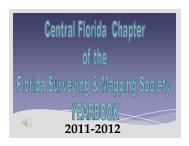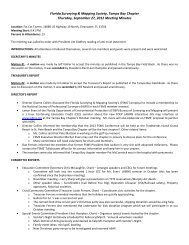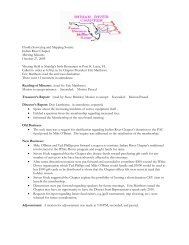July 2012 - FSMS
July 2012 - FSMS
July 2012 - FSMS
Create successful ePaper yourself
Turn your PDF publications into a flip-book with our unique Google optimized e-Paper software.
29 CFR Part 1915, Subpart B, Confined and Enclosed<br />
Spaces and Other Dangerous Atmospheres in Shipyard<br />
Employment. CPL 02-01-042, (2005, September 7).<br />
Search all available directives.<br />
Standard Interpretations<br />
Clarification of "potential atmospheric hazard" when reclassifying<br />
a PRCS as a non-permit required confined<br />
space. (2005, December 2).<br />
Clarification of "continuous forced air ventilation" for<br />
PRCS entry work. (2005, November 17).<br />
Search all available standard interpretations.<br />
National Consensus<br />
Note: These are NOT OSHA regulations. However, they do<br />
provide guidance from their originating organizations related<br />
to worker protection.<br />
American National Standards Institute (ANSI)/American Society<br />
of Safety Engineers (ASSE)<br />
Z117.1 - 2003, Safety Requirements for Confined Spaces.<br />
Page current as of: 08/20/2007 2<br />
Appendix E reads as follows:<br />
Regulations (Standards - 29 CFR) - Table of Contents<br />
Part Number: 1910<br />
Part Title: Occupational Safety and Health Standards<br />
Subpart: J<br />
Subpart Title: General Environmental Controls<br />
Standard Number: 1910.146 App E<br />
Title: Sewer System Entry.<br />
Sewer entry differs in three vital respects from other permit<br />
entries:<br />
1st: there rarely exists any way to completely isolate the<br />
space ([it is] a section of a continuous system) to be entered;<br />
2nd: because isolation is not complete, the atmosphere<br />
may suddenly and unpredictably become lethally hazardous<br />
(toxic, flammable or explosive) from causes beyond<br />
the control of the entrant or employer, and<br />
3rd: experienced sewer workers are especially knowledgeable<br />
in entry and work in their permit spaces because of<br />
their frequent entries.<br />
Unlike other employments where permit space entry is a<br />
rare and exceptional event, sewer workers' usual work environment<br />
is a permit space.<br />
(1) Adherence to procedure. The employer should designate<br />
as entrants only employees who are thoroughly trained<br />
in the employer's sewer entry procedures and who demonstrate<br />
that they follow these entry procedures exactly as<br />
prescribed when performing sewer entries.<br />
(2) Atmospheric monitoring. Entrants should be trained in<br />
the use of, and be equipped with, atmospheric monitoring<br />
equipment which sounds an audible alarm, in addition to its<br />
visual readout, whenever one of the following conditions are<br />
encountered:<br />
a) oxygen concentration less than 19.5 percent;<br />
b) flammable gas or vapor at 10 percent or more of the<br />
lower flammable limit (LFL);<br />
c) or hydrogen sulfide or carbon monoxide at or above 10<br />
ppm or 35 ppm, respectively, measured as an 8-hour<br />
time-weighted average.<br />
Atmospheric monitoring equipment needs to be calibrated<br />
according to the manufacturer's instructions. The oxygen<br />
sensor/broad range sensor is best suited for initial use in<br />
situations where the actual or potential contaminants have<br />
not been identified, because broad range sensors, unlike<br />
substance-specific sensors, enable employers to obtain an<br />
overall reading of the hydrocarbons (flammables) present in<br />
the space. However, such sensors only indicate that a hazardous<br />
threshold of a class of chemicals has been exceeded.<br />
They do not measure the levels of contamination of<br />
specific substances. Therefore, substance-specific devices,<br />
which measure the actual levels of specific substances, are<br />
best suited for use where actual and potential contaminants<br />
have been identified. The measurements obtained with substance-specific<br />
devices are of vital importance to the employer<br />
when decisions are made concerning the measures<br />
necessary to protect entrants (such as ventilation or personal<br />
protective equipment) and the setting and attainment<br />
of appropriate entry conditions. However, the sewer environment<br />
may suddenly and unpredictably change and the<br />
substance-specific devices may not detect the potentially<br />
lethal atmospheric hazards which may enter the sewer environment.<br />
Although OSHA considers the information and guidance<br />
provided above to be appropriate and useful in most sewer<br />
entry situations, the Agency emphasizes that each employer<br />
must consider the unique circumstances, including the predictability<br />
of the atmosphere, of the sewer permit spaces in<br />
the employer's workplace in preparing for entry. Only the<br />
employer can decide, based upon his or her knowledge of,<br />
and experience with permit spaces in sewer systems, what<br />
the best type of testing instrument may be for any specific<br />
entry operation.<br />
The selected testing instrument should be carried and used<br />
by the entrant in sewer line work to monitor the atmosphere<br />
in the entrant's environment, and in advance of the entrant's<br />
direction of movement, to warn the entrant of any deterioration<br />
in atmospheric conditions. Where several entrants are<br />
working together in the same immediate location, one instrument,<br />
used by the lead entrant, is acceptable.<br />
(3) Surge flow and flooding. Sewer crews should develop<br />
and maintain liaison, to the extent possible, with the local<br />
weather bureau and fire and emergency services in their<br />
area so that sewer work may be delayed or interrupted and<br />
entrants withdrawn whenever sewer lines might be suddenly<br />
flooded by rain or fire suppression activities, or whenever<br />
flammable or other hazardous materials are released into<br />
sewers during emergencies by industrial or transportation<br />
accidents.<br />
[The existence of large rain storms of sufficient size to warrant<br />
hazards in this area are a rare find in Florida, partially in<br />
the size of sewers found in Florida.]<br />
(4) Special Equipment. Entry into large bore sewers may<br />
require the use of special equipment. Such equipment might<br />
include such items as atmosphere monitoring devices with<br />
automatic audible alarms, escape self-contained breathing<br />
apparatus (ESCBA) with at least 10 minute air supply (or<br />
other National Institute Occupational Safety and Health approved<br />
self-rescuer), and waterproof flashlights, and may<br />
also include boats and rafts, radios and rope stand-offs for<br />
pulling around bends and corners as needed.



